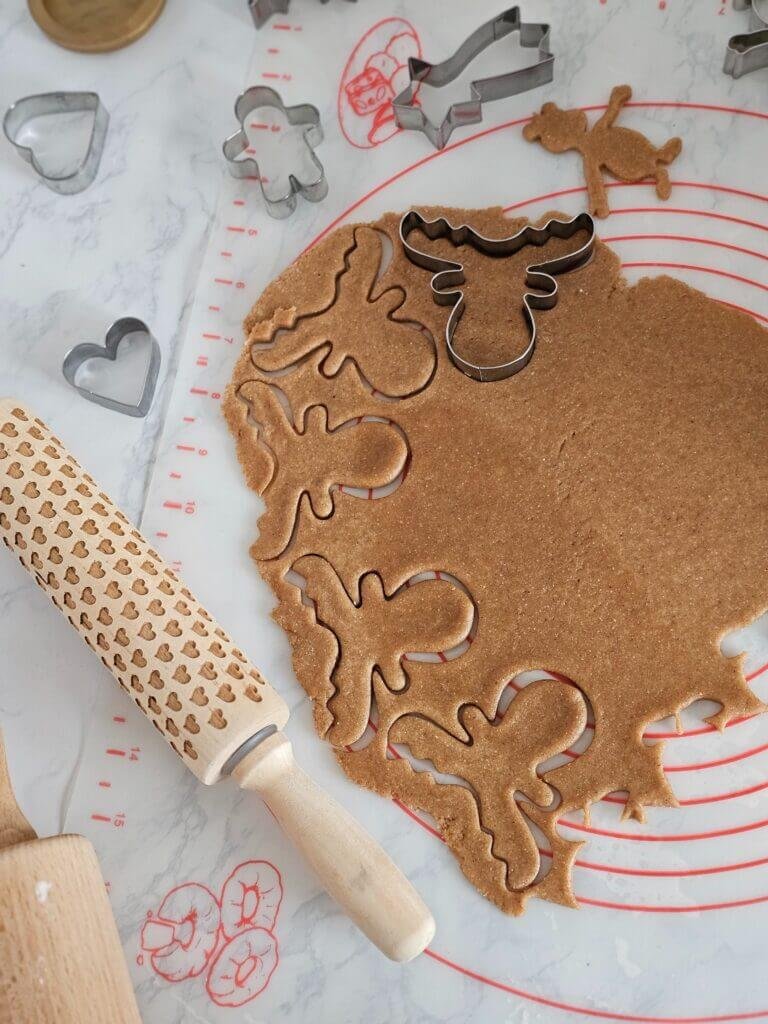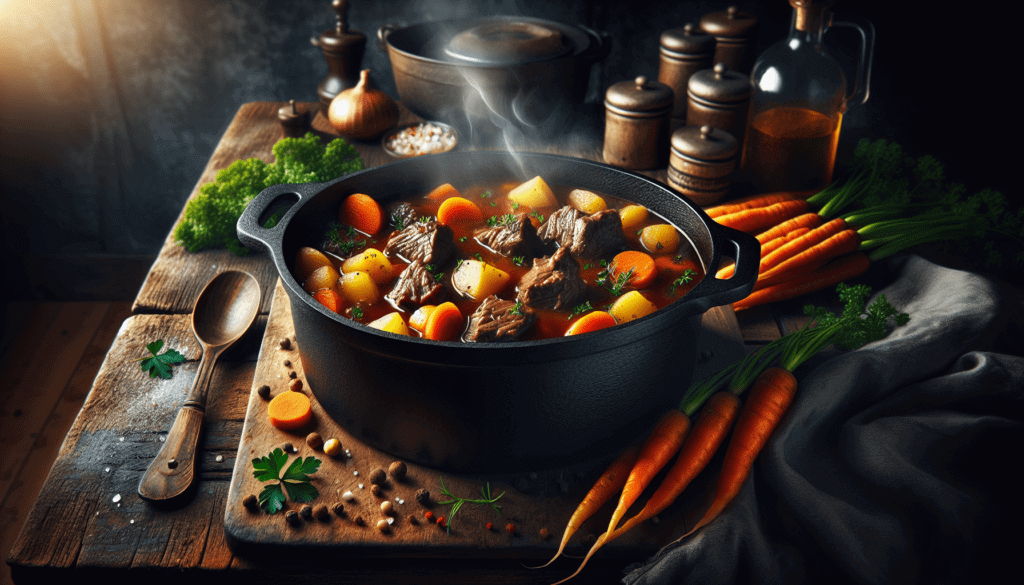So, you’re craving a hearty, delicious bowl of beef stew and you want to make it yourself. Well, you’ve come to the right place! In this article, we’ll guide you step-by-step on how to make the perfect beef stew that will warm your soul and leave you craving for more. Get ready to embark on a flavorful journey as we share our secrets to creating a mouthwatering, tender beef stew that will have your taste buds dancing with joy. Get your apron on and let’s get cooking!

Choosing the Right Cut of Beef
When it comes to making a delicious beef stew, choosing the right cut of beef is essential. You want a cut of meat that is both flavorful and tender. Some of the best cuts for stew include chuck roast, beef blade roast, and beef shank. These cuts are perfect for slow cooking because they have a good amount of marbling and connective tissue, which will break down and add richness to your stew as it cooks.
Trimming and Cutting the Beef
Before you start preparing your stew, it’s important to trim and cut the beef into bite-sized pieces. Remove any excess fat or gristle from the meat, as it can result in a greasy stew. Cut the beef into cubes, ensuring that they are all similar in size. This will help with even cooking and ensure that your stew has a consistent texture.
Marinating the Beef
To add even more flavor to your stew, you can marinate the beef before cooking. A simple marinade consisting of olive oil, garlic, Worcestershire sauce, and herbs such as rosemary and thyme can work wonders. Place the cubed beef in a bowl and pour the marinade over it, making sure each piece is coated. Let it marinate in the refrigerator for at least 30 minutes, or overnight for a more intense flavor.
Gathering the Necessary Ingredients
As with any recipe, gathering all the necessary ingredients beforehand will make the cooking process much smoother. For a delicious beef stew, you’ll need ingredients such as beef, onions, garlic, carrots, potatoes, beef stock or broth, spices like salt, black pepper, and paprika, as well as fresh herbs like thyme and bay leaves. Having all your ingredients measured and ready to go will save you time and prevent any last-minute scrambling.

Chopping the Vegetables
Next, it’s time to chop the vegetables that will go into your beef stew. Dice the onions, mince the garlic, and cut the carrots and potatoes into bite-sized pieces. Chopping the vegetables into similar sizes will ensure they cook evenly and add a pleasant texture to your stew. Remember to keep the vegetables separate as they will be added to the stew at different times during the cooking process.
Measuring the Spices and Herbs
To achieve the perfect balance of flavors in your beef stew, it’s crucial to measure out the spices and herbs accurately. Start with salt and pepper to taste, being mindful not to overdo it. Add a teaspoon or two of paprika for a smoky undertone, and don’t forget the aromatic herbs like thyme and bay leaves. These herbs will infuse your stew with a wonderful depth of flavor. Measure out the spices and herbs in advance, so they’re ready to be added to the pot when the timing is right.
Heating the Cooking Oil
Before you can sear the beef, it’s important to heat the cooking oil in a large pot or Dutch oven over medium-high heat. The oil should be heated until shimmering, which helps create a nice sear on the beef and prevents it from sticking to the pot. Use an oil with a high smoke point, such as canola or vegetable oil, to ensure the best results.
Seasoning and Searing the Beef
Once the oil is heated, it’s time to season and sear the beef. Remove the beef from the marinade, allowing any excess marinade to drip off. Season the beef with salt and pepper to taste, ensuring that each piece is coated evenly. Carefully place the beef in the hot oil, being sure not to overcrowd the pot. Sear the beef on all sides until it develops a nice golden brown crust. This step adds depth and richness to the stew’s flavor profile.

Removing the Beef from the Pot
After the beef has been seared to perfection, remove it from the pot and set it aside for later. This allows all the flavors from the searing process to stay in the pot and infuse the rest of the stew. Keep the beef covered to prevent it from drying out while you continue with the next steps.
Sauteing Onion and Garlic
To build even more flavor, begin by sautéing diced onion and minced garlic in the same pot used to sear the beef. The residual oil and beef drippings will add a delicious depth to the aromatic base. Stir the onion and garlic frequently, cooking until they become translucent and fragrant. This step infuses the stew with a rich, savory foundation.
Adding Other Aromatics
Once the onion and garlic are sautéed to perfection, it’s time to add other aromatic ingredients to the pot. You can enhance the flavor profile of your beef stew by adding ingredients such as diced celery, sliced mushrooms, or bell peppers. These additional aromatics will contribute their own unique flavors, taking your stew to new heights of deliciousness.
Deglazing the Pot
To ensure that none of the flavorful bits from the bottom of the pot go to waste, it’s important to deglaze the pot. Deglazing is the process of adding a liquid, such as wine, broth, or even water, to the hot pot and scraping up any browned bits that may be stuck to the bottom. This technique not only helps to remove any residue but also adds extra flavor and depth to your stew. Pour the liquid into the pot and use a wooden spoon or spatula to scrape up the browned bits, incorporating them into the stew.

Selecting the Base Liquid
Next, it’s time to choose the base liquid for your beef stew. Traditional options include beef stock or broth, which add richness and depth to the stew’s flavor. You can also experiment with using a combination of stock and other liquids such as red wine or beer for added complexity. The liquid you choose will depend on your personal taste preferences and desired flavor profile.
Adding Beef Stock or Broth
Once you’ve selected your base liquid, it’s time to add the beef stock or broth to the pot. Pour the liquid into the pot, covering the sautéed onions, garlic, and deglazed bits. The stock or broth will provide the stew with the necessary moisture and help to further tenderize the beef as it simmers. Be sure to use enough liquid to ensure that all the ingredients are fully submerged.
Using Wine or Beer for Extra Flavor
For those looking to enhance the flavor of their beef stew even further, adding a splash of wine or beer can do wonders. Red wine adds a robust, deep flavor, while beer brings a unique and complex taste to the stew. The alcohol will cook off during the simmering process, leaving behind a rich and flavorful base for your stew. Experiment with different varieties to discover your preferred flavor combination.
Choosing the Right Spices
When it comes to seasoning your beef stew, selecting the right spices is key. Classic choices include bay leaves and thyme, which add a warm and aromatic element to the dish. Other popular options include paprika, rosemary, and cayenne pepper, which can add depth and a hint of spice. Remember to be mindful of the overall balance of flavors and season to taste, adjusting the amount of spice based on your preferences.

Balancing the Flavors
Achieving a well-balanced stew requires careful consideration of the flavors at play. Taste your stew as it cooks and adjust the seasonings as needed. Experiment with adding a bit of salt or a squeeze of lemon juice to enhance the flavors. Don’t be afraid to trust your taste buds and make adjustments accordingly. A well-balanced stew will have layers of flavors that work harmoniously together.
Using Bay Leaves and Thyme
To add an extra layer of aromatic complexity to your beef stew, the addition of bay leaves and thyme is highly recommended. Bay leaves impart a subtle earthy flavor, while thyme brings a touch of freshness. These herbs infuse the stew with their unique qualities and enhance the overall taste. Remember to fish out the bay leaves before serving, as their texture can be tough and unpleasant to eat.
Incorporating Potatoes and Carrots
No beef stew is complete without the addition of hearty vegetables like potatoes and carrots. Peel and chop the potatoes and carrots into bite-sized pieces, ensuring they are all of similar size for even cooking. Adding them to the stew along with the beef ensures that they absorb all the delicious flavors and become tender and flavorful. These vegetables add both texture and nutrients to the stew, making it a wholesome and satisfying meal.
Adding Other Vegetables
While potatoes and carrots are classic additions to beef stew, there are many other vegetables you can incorporate to add variety and color to your dish. Consider adding diced celery, sliced mushrooms, or peas to further enhance the flavors and textures. These additional vegetables will add richness and depth to your stew, making it even more satisfying.
Including Fresh Herbs
Fresh herbs are a wonderful way to elevate the flavors of your beef stew. Consider adding chopped fresh herbs such as parsley or rosemary towards the end of the cooking process. These herbs add a vibrant freshness to the stew and create a beautiful harmony of flavors. Sprinkle the herbs on top of the stew just before serving for a burst of freshness that will impress your taste buds.
Covering and Simmering the Stew
Once all the ingredients have been added to the pot, it’s time to cover and let the stew simmer. Cover the pot with a lid to trap the heat and moisture, allowing the flavors to develop and the beef to become tender. Simmering the stew low and slow will break down the tough collagen in the beef, resulting in melt-in-your-mouth goodness. Simmer for at least 1-2 hours, or until the beef is tender and the flavors have melded together.
Adjusting the Heat
During the simmering process, it’s important to monitor the heat and make any necessary adjustments. You want the stew to maintain a gentle simmer, with small bubbles occasionally breaking the surface. If the heat is too high, the stew may boil vigorously, resulting in overcooked meat and vegetables. If the heat is too low, the stew may not cook through properly or take longer to become tender. Adjust the heat as needed to ensure an ideal simmer.
Braising for Tender Beef
For those looking for exceptionally tender beef in their stew, consider braising the meat. Braising refers to cooking the meat in a liquid over low heat for an extended period. This slow cooking method helps break down the tough collagen in the beef, resulting in tender, succulent meat. You can braise the beef by adding it back to the pot and letting it cook in the stewing liquid until it reaches the desired level of tenderness.
Creating a Roux
To thicken your beef stew and give it a rich, silky texture, consider creating a roux. A roux is a mixture of equal parts fat (usually butter) and flour, used as a thickening agent. Start by melting butter in a separate pan over medium heat. Once melted, gradually whisk in flour until it forms a smooth paste. Cook the roux for a few minutes, stirring constantly, until it becomes a light golden color. Be careful not to burn it.
Adding Roux to the Stew
Once your roux is ready, carefully add it to the simmering pot of stew. Stir the stew vigorously to ensure the roux mixes in well and there are no clumps. The roux will thicken the stew and give it a luxurious texture. If you prefer a thinner stew, you can skip this step or use less roux. Be sure to taste and adjust the seasonings after adding the roux, as it may change the overall flavor profile of the stew slightly.
Finishing with Fresh Parsley
Just before serving, garnish your beef stew with a sprinkle of fresh parsley. Chopped fresh parsley adds a pop of color and freshness to the dish, elevating its visual appeal. The herb also adds a subtle, herbaceous flavor that complements the other ingredients in the stew. Sprinkle the parsley on top of each serving, allowing the vibrant green color to contrast beautifully with the rich browns and reds of the stew.
Allowing the Stew to Rest
Once your beef stew is fully cooked, it’s important to allow it to rest before serving. This allows the flavors to meld together even further and results in a more cohesive and well-rounded dish. Remove the pot from the heat and let it sit, covered, for about 10 minutes. The resting time will also allow the stew to cool slightly, making it safer to handle and enjoy.
Serving Suggestions
When it comes to serving your beef stew, there are several delicious options to consider. A classic choice is to serve it with a side of crusty bread, perfect for soaking up the flavorful broth. Alternatively, you can serve it over a bed of mashed potatoes or a fluffy mound of rice for a more substantial meal. Consider garnishing each serving with a sprig of fresh thyme or a dollop of sour cream for an extra touch of elegance.
Proper Storage for Leftovers
If you have any leftovers from your delicious beef stew, it’s important to store them properly to maintain their freshness and flavor. Allow the stew to cool completely before transferring it to an airtight container or individual portion containers. Store the stew in the refrigerator for up to three days or in the freezer for up to three months. When reheating, do so gently over low heat to avoid overcooking the meat and vegetables. Enjoy your flavorful beef stew whenever you crave comforting, homemade goodness.


